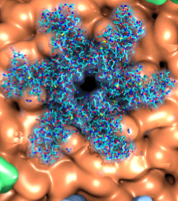Release 3.0 of NAMD retains the same well-known parallel scaling
capabilities of previous versions while adding improved support
for GPU acceleration. A new GPU-resident mode has been introduced
that more than doubles simulation performance for a single GPU and
scales more efficiently across NVIDIA DGX architectures than NAMD's
GPU-offload mode provided in the earlier version 2.x releases.
With GPU-resident mode,
NAMD
is capable of simulating small systems,
such as the 24k-atom DHFR using AMBER force field parameters, at a
rate of more than
1 microsecond of simulated time per day.
Several
advanced features and enhanced sampling methodologies
are available for GPU-resident mode,
such as alchemical free energy methods,
the Colvars collective variables module, and TCL forces.
The Future of Biomolecular Modeling
A 2015 TCBG Symposium brought together scientists from across the Midwest to brainstorm about what's on the horizon for computational modeling. See a summary of what these experts foresee.
Read more
A Look Ahead
The Urbana NIH Center previews what it will propose for the 2017-2022 funding cycle. By Lisa Pollack.
Read more
Announcements
Electron transport through peptidesTCBG members on TV newsSparing healthy microbes while using a novel antibioticTajkhorshid receives Beckman Institute Vision and Spirit Award
Seminars
Remembering Klaus Schulten
Recent Publications All Publications
- GOLEM: Automated and Robust Cryo-EM-Guided Ligand Docking with Explicit Water Molecules. J. Chem. Inf. Model., 2024.
- Broadening access to small-molecule parameterization with the force field toolkit. J. Chem. Phys., 160:242501. 2024.
- Topological Learning Approach to Characterizing Biological Membranes. J. Chem. Inf. Model., 64:5242-5252. 2024.
- APACE: AlphaFold2 and advanced computing as a service for accelerated discovery in biophysics. PNAS, 121:e2311888121. 2024.
- Improved Highly Mobile Membrane Mimetic Model for Investigating Protein–Cholesterol Interactions. Nat. Commun., 64:4822-4834. 2024.
- A Gram-negative-selective antibiotic that spares the gut microbiome. Nat. Commun., 630:429-436. 2024.
- Beyond nothingness in the formation and functional relevance of voids in polymer films. Nat. Commun., 15:2852. 2024.







